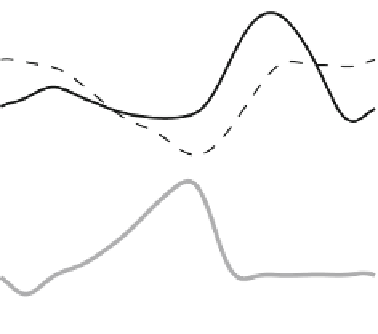Biomedical Engineering Reference
In-Depth Information
Fig. 4 a Sagittal plane
angles of ankle, knee, and hip
joints over a normal gait
cycle. Flexion and
dorsiflexion angles are
positive. b Sagittal plane joint
moments normalized by body
weight, extensor and plantar
flexor moments are positive.
c Frontal plane normalized
moments, adductor moments
(i.e. external abduction
moments) are positive
Ankle
Knee
Hip
(a)
50
0
−25
(b)
1
0
−.5
1
(c)
.5
0
0
60
100
Gait cycle (%)
A possible explanation for the slower walking speed, shorter strides and wider
step width in obese compared the normal-weight individuals could be that the
obese tend to provide more balance to the gait and thus prevent the risk of falling
[
12
,
51
]. This explanation is supported by a study in which the investigators added
an extra 20 % of body weight to the upper part of the trunk of normal-weight
participants, which resulted in larger sway areas [
26
]. Obese subjects might also
choose a more comfortable gait and shorten their stride length as a consequence of
the decreased gait speed [
40
]. It could also be possible that the wider step width in
obese individuals could be naturally due to the enormous amount of fat mass
between the thighs. The slower walking speed in obese subjects might additionally
been explained by the adipose tissue over the abdomen and in the hip region
limiting the degree of hip flexion, which leads to shorter steps and further to a
decreased gait speed [
40
]. It is also possible that because absolute GFRs are
significantly greater in obese subjects compared to lean subjects [
7
], obese indi-
viduals try to minimize joint loadings by walking at a slower speed and by
shortening their stride length [
32
], especially if joint pain is present.




















































Search WWH ::

Custom Search